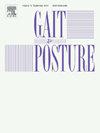A physics-informed deep learning approach to predicting bilateral ground reaction forces and centre of pressure from a single forceplate during gait
IF 2.2
3区 医学
Q3 NEUROSCIENCES
引用次数: 0
Abstract
Background
Measuring bilateral ground reaction forces (GRFs) and centre of pressure (COP) is essential in gait analysis, requiring subjects to step each foot sequentially onto a separate forceplate. However, this requirement often causes multiple trial attempts, especially in patients with neuromusculoskeletal disorders. Consciously targeting the forceplates could also alter walking mechanics, leading to unnatural gait patterns.
Research question
This study aimed to (1) develop a novel physics-informed residual recurrent neural network (PI-ResRNN) to predict bilateral GRF and COP during gait using data from a single forceplate and (2) evaluate its accuracy against ground truth obtained across subject groups of different ages and pathologies.
Methods
Forceplate data from 315 participants, namely healthy participants and patients with six types of neuromusculoskeletal disorders, was collected. Data from 6765 trials was used to train and validate the PI-ResRNN model to decompose GRF and COP for each foot during the double-contact phase of walking. Model-predicted COP and GRFs were evaluated against the ground truth using root-mean-square errors (RMSE) and relative RMSE (rRMSE), respectively.
Results
All predicted variables from the PI-ResRNN model demonstrated high consistency with the ground truth, with mean rRMSE values below 0.34 %, 0.38 %, and 0.56 % in the vertical, anteroposterior, and mediolateral GRFs, respectively, and mean RMSE values for COP below 3.0 mm. The model effectively identified statistical between-group differences compared with the ground truth.
Significance
The proposed model provides a practical and accurate approach for obtaining bilateral GRF and COP using a single forceplate, benefiting gait analysis in populations with mobility impairments.
一种基于物理的深度学习方法,用于预测步态过程中来自单个力板的双边地面反作用力和压力中心
测量双侧地面反作用力(GRFs)和压力中心(COP)在步态分析中是必不可少的,需要受试者将每只脚依次踩到一个单独的力板上。然而,这一要求经常导致多次试验尝试,特别是在神经肌肉骨骼疾病患者中。有意识地瞄准力板也可能改变行走机制,导致不自然的步态模式。本研究旨在(1)开发一种新的物理信息残差递归神经网络(PI-ResRNN),利用单个力板的数据预测步态过程中的双侧GRF和COP;(2)根据不同年龄和病理的受试者群体获得的基本事实评估其准确性。方法收集315例健康受试者和6种神经肌肉骨骼疾病患者的力板数据。使用6765个试验的数据来训练和验证PI-ResRNN模型,以分解行走双接触阶段每只脚的GRF和COP。模型预测的COP和GRFs分别使用均方根误差(RMSE)和相对RMSE (rRMSE)根据真实情况进行评估。结果PI-ResRNN模型预测的所有变量均与实际情况具有较高的一致性,垂直、正侧和中侧GRFs的平均RMSE值分别低于0.34 %、0.38 %和0.56 %,COP的平均RMSE值低于3.0 mm。该模型有效地识别了组间统计差异与基础事实。意义该模型提供了一种实用且准确的方法,可以使用单个力板获得双侧GRF和COP,有利于行动障碍人群的步态分析。
本文章由计算机程序翻译,如有差异,请以英文原文为准。
求助全文
约1分钟内获得全文
求助全文
来源期刊

Gait & posture
医学-神经科学
CiteScore
4.70
自引率
12.50%
发文量
616
审稿时长
6 months
期刊介绍:
Gait & Posture is a vehicle for the publication of up-to-date basic and clinical research on all aspects of locomotion and balance.
The topics covered include: Techniques for the measurement of gait and posture, and the standardization of results presentation; Studies of normal and pathological gait; Treatment of gait and postural abnormalities; Biomechanical and theoretical approaches to gait and posture; Mathematical models of joint and muscle mechanics; Neurological and musculoskeletal function in gait and posture; The evolution of upright posture and bipedal locomotion; Adaptations of carrying loads, walking on uneven surfaces, climbing stairs etc; spinal biomechanics only if they are directly related to gait and/or posture and are of general interest to our readers; The effect of aging and development on gait and posture; Psychological and cultural aspects of gait; Patient education.
 求助内容:
求助内容: 应助结果提醒方式:
应助结果提醒方式:


